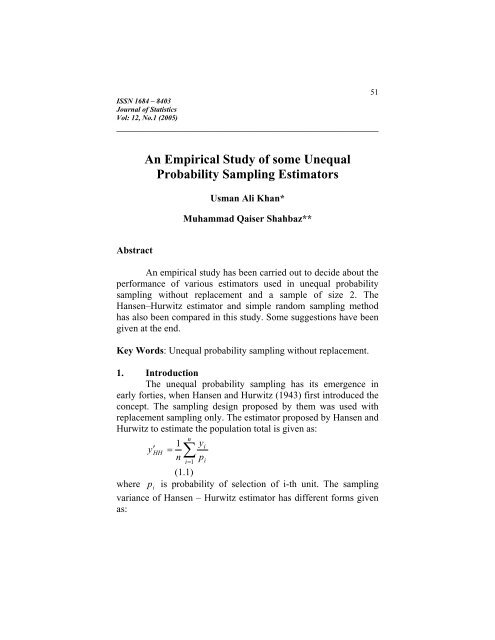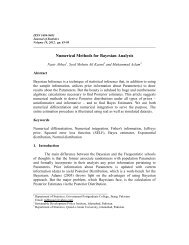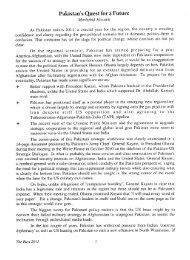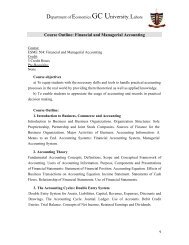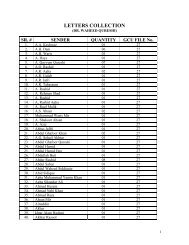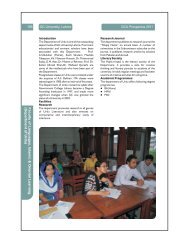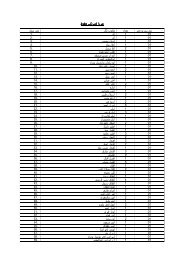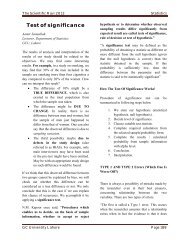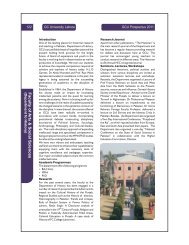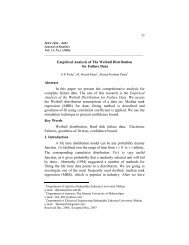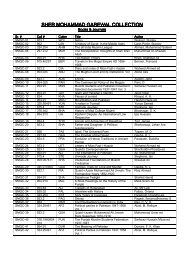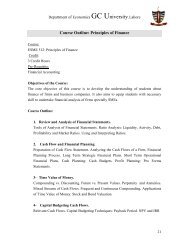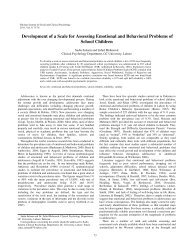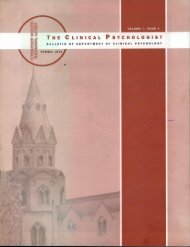An Empirical Study of some Unequal Probability Sampling Estimators
An Empirical Study of some Unequal Probability Sampling Estimators
An Empirical Study of some Unequal Probability Sampling Estimators
You also want an ePaper? Increase the reach of your titles
YUMPU automatically turns print PDFs into web optimized ePapers that Google loves.
51<br />
ISSN 1684 – 8403<br />
Journal <strong>of</strong> Statistics<br />
Vol: 12, No.1 (2005)<br />
______________________________________________________<br />
<strong>An</strong> <strong>Empirical</strong> <strong>Study</strong> <strong>of</strong> <strong>some</strong> <strong>Unequal</strong><br />
<strong>Probability</strong> <strong>Sampling</strong> <strong>Estimators</strong><br />
Usman Ali Khan*<br />
Muhammad Qaiser Shahbaz**<br />
Abstract<br />
<strong>An</strong> empirical study has been carried out to decide about the<br />
performance <strong>of</strong> various estimators used in unequal probability<br />
sampling without replacement and a sample <strong>of</strong> size 2. The<br />
Hansen–Hurwitz estimator and simple random sampling method<br />
has also been compared in this study. Some suggestions have been<br />
given at the end.<br />
Key Words: <strong>Unequal</strong> probability sampling without replacement.<br />
1. Introduction<br />
The unequal probability sampling has its emergence in<br />
early forties, when Hansen and Hurwitz (1943) first introduced the<br />
concept. The sampling design proposed by them was used with<br />
replacement sampling only. The estimator proposed by Hansen and<br />
Hurwitz to estimate the population total is given as:<br />
n<br />
1 yi<br />
y′<br />
HH =<br />
n∑<br />
p<br />
i=<br />
1 i<br />
(1.1)<br />
where p<br />
i<br />
is probability <strong>of</strong> selection <strong>of</strong> i-th unit. The sampling<br />
variance <strong>of</strong> Hansen – Hurwitz estimator has different forms given<br />
as:
52<br />
Khan and Shahbaz<br />
______________________________________________________<br />
* AC-Nilson Aftab Associates, Lahore.<br />
** Department <strong>of</strong> Statistics, Government College University, Lahore.<br />
/<br />
y HH<br />
Var ( ) =<br />
(1.2)<br />
1 ⎛Y<br />
Y ⎞<br />
2n P P ⎟<br />
⎠<br />
N<br />
i j<br />
ΣΣ PP<br />
i j<br />
−<br />
⎜<br />
i= 1 j=<br />
1<br />
⎝ i j<br />
j≠i<br />
N<br />
1 1<br />
2<br />
∑ i i i<br />
n P<br />
i=<br />
1 i<br />
= ( Y − PY )<br />
(1.3)<br />
The concept <strong>of</strong> unequal probability sampling without<br />
replacement was first introduced by Madow (1949) but no<br />
theoretical framework was given. Horvitz and Thompson (1952)<br />
gave the first theoretical framework <strong>of</strong> unequal probability<br />
sampling. They also proposed their selection procedure and an<br />
estimator <strong>of</strong> population total. The estimator proposed by Horvitz<br />
and Thompson is given as:<br />
y′<br />
HT<br />
=<br />
∑<br />
i∈s<br />
Y<br />
i<br />
π ,<br />
i<br />
(1.4)<br />
where π<br />
i<br />
is probability <strong>of</strong> inclusion <strong>of</strong> i-th unit in the sample.<br />
Horvitz and Thompson gave following variance formula for<br />
estimator (1.4).<br />
N<br />
N<br />
( 1−π<br />
) ( π ij −π<br />
iπ<br />
)<br />
i 2<br />
j<br />
V ( y′<br />
HT ) = ∑ Yi<br />
+ ∑∑<br />
YiY<br />
j<br />
π<br />
π π<br />
i=<br />
1 i<br />
i,<br />
j=<br />
1<br />
j≠i<br />
(1.5)<br />
an alternative expression, for fixed n, given by Sen (1953) and<br />
independently by Yates and Grundy (1953), is:<br />
V ( y′ HT ) =<br />
ΣΣ<br />
( π π −π<br />
)<br />
N<br />
⎜<br />
Yi<br />
j<br />
i j ij −<br />
= 1 = 1 ⎝ π i π<br />
i j<br />
j<br />
j > i<br />
(1.6)<br />
⎛<br />
Y<br />
⎞<br />
⎟<br />
⎠<br />
2<br />
2<br />
i<br />
j
53<br />
Since the emergence <strong>of</strong> Horvitz and Thompson estimator a number<br />
<strong>of</strong> selection procedures have been developed that can be used with<br />
this estimator. Raj (1956a) introduced his estimator based on the<br />
order <strong>of</strong> selection <strong>of</strong> units. The estimator proposed by Raj (1956a)<br />
is given as:<br />
t<br />
1<br />
=<br />
n<br />
∑<br />
mean t r<br />
n<br />
r=<br />
1<br />
(1.7)<br />
where<br />
r−1<br />
⎛<br />
r−1<br />
y ⎞<br />
= +<br />
r<br />
t ⎜ − ⎟<br />
r ∑ yi<br />
1<br />
∑ pi<br />
(1.8)<br />
p<br />
i=<br />
1 r ⎝ i=<br />
1 ⎠<br />
The Raj (1956a) estimator for a sample <strong>of</strong> size 2 is given as:<br />
1 ⎡ yi<br />
yi<br />
⎤<br />
tmean<br />
= ⎢ ( 1+<br />
pi<br />
) + ( 1−<br />
p j ) ⎥⎦ (1.9)<br />
2 ⎣ pi<br />
pi<br />
the sampling variance <strong>of</strong> estimator given in (1.9) is given as:<br />
N<br />
1<br />
⎛ ⎞<br />
( ) ( 2 ) ⎜<br />
Y Y<br />
Var t = − −<br />
⎟<br />
mean<br />
8ΣΣ<br />
P P P P<br />
(1.10)<br />
⎠<br />
i j<br />
i j i j −<br />
⎜<br />
= 1 1<br />
⎝<br />
P<br />
≠ =<br />
i P<br />
i j<br />
j<br />
j i<br />
Raj’s estimator has defect that it is based on order <strong>of</strong> the units in<br />
which they are selected. Murthy (1957) uses the idea <strong>of</strong> sufficiency<br />
to overcome the defect <strong>of</strong> Raj estimator. He symmetrized the Raj<br />
estimator to produce an un-ordered estimator. The estimator<br />
proposed by Murthy has general form:<br />
t<br />
=<br />
where ( s i)<br />
1<br />
() s<br />
∑<br />
( s i)<br />
symm y i<br />
P<br />
i = 1<br />
n<br />
P<br />
2<br />
(1.11)<br />
P is the probability <strong>of</strong> obtaining a sample “s” given<br />
that ith unit has been already selected and P ( s)<br />
is the probability<br />
<strong>of</strong> obtaining a sample “s”<br />
The Murthy (1957) estimator for a sample <strong>of</strong> size 2 is given as:<br />
t = 1 ⎡ y y ⎤<br />
i<br />
j<br />
symm<br />
⎢ ( 1−<br />
p j ) + ( − p ) ⎥<br />
− p − ⎢⎣<br />
i<br />
i p j pi<br />
p<br />
1<br />
(1.12)<br />
2<br />
j ⎥⎦<br />
The sampling variance for estimator given in (1.12) is given as:
54<br />
Khan and Shahbaz<br />
( 1−<br />
P − P )<br />
1 P P<br />
⎛ Y ⎞<br />
Var ( t ) = ⎟<br />
symm<br />
2ΣΣ<br />
(1.13)<br />
⎠<br />
N<br />
i j i j<br />
⎜<br />
Yi<br />
j<br />
⋅ −<br />
2 − P −<br />
= 1 1<br />
⎝<br />
≠ =<br />
i Pj<br />
P<br />
i j<br />
i Pj<br />
j i<br />
The estimators given so far, for unequal probability sampling<br />
without replacement, are very hard to apply for a sample <strong>of</strong> size<br />
more than 2. To overcome this defect Rao – Hartley and Cochran<br />
(1962) proposed an estimator that can be used with a sample <strong>of</strong> any<br />
size. The estimator proposed by them is given as:<br />
y<br />
n<br />
/ π i yiT<br />
RHC = ∑<br />
p<br />
i = 1 iT<br />
2<br />
(1.14)<br />
where p<br />
iT<br />
is the probability <strong>of</strong> T-th unit selected from the i-th<br />
Ni<br />
n<br />
group. Also π i = ∑ piT<br />
and ∑π<br />
i = 1.<br />
The sampling variance <strong>of</strong><br />
T = 1<br />
i = 1<br />
estimator given in (1.14) is:<br />
⎛ n ⎞<br />
⎜ 2<br />
n<br />
⎟<br />
⎜∑<br />
Ni<br />
− N<br />
⎟ ⎡<br />
/<br />
( )<br />
⎝ i = 1<br />
Var y<br />
⎠<br />
RHC<br />
⋅⎢<br />
N N −1<br />
⎢<br />
⎣<br />
= ∑∑<br />
n<br />
Y<br />
−<br />
( ) n P n ⎥ ⎥ i = 1 T = 1 iT<br />
⎦<br />
N<br />
Y<br />
2<br />
iT<br />
i 2<br />
⎤<br />
(1.15)<br />
2. The <strong>Empirical</strong> <strong>Study</strong><br />
In this section the empirical study has been given in order<br />
to decide about the performance <strong>of</strong> various estimators in unequal<br />
probability sampling without replacement. To carry out the study<br />
fifty natural populations have been used, which are given in<br />
standard texts on sampling techniques. The sampling variance <strong>of</strong><br />
estimators given in section 1 has been obtained for all the<br />
populations. After evaluating the sampling variance, ranking has<br />
been done for each estimator according to the sampling variance.<br />
The average rank <strong>of</strong> each estimator has been calculated for various<br />
ranges <strong>of</strong> ranks <strong>of</strong> coefficient <strong>of</strong> variation <strong>of</strong> measure <strong>of</strong> size and<br />
correlation coefficient between actual variable <strong>of</strong> study and the<br />
measure <strong>of</strong> size. The average ranks have also been calculated for<br />
various actual ranges <strong>of</strong> the coefficient <strong>of</strong> variation and correlation<br />
coefficient. It should be noticed that an estimator with smaller
55<br />
average rank will have better performance as compared to <strong>some</strong><br />
other estimator with a larger average rank. The results <strong>of</strong> the<br />
empirical study have been given in following tables.<br />
Table 1: Average Ranks <strong>of</strong> Various <strong>Estimators</strong><br />
with ranks <strong>of</strong> Coefficient <strong>of</strong> Variation.<br />
CV (Z) SRS HH<br />
HT<br />
(YG)<br />
HT<br />
Brewer RHC Raj Murthy<br />
1 – 10 5.8 6.1 2.6 3.3 2.8 4.7 2.4<br />
11 – 20 5.2 6.3 3.3 3.1 3.6 4.1 2.4<br />
21 – 30 7.0 6.0 2.2 3.8 3.4 3.5 2.1<br />
31 – 40 5.2 6.2 2.3 4.1 4.4 3.5 2.3<br />
41 – 50 5.8 6.0 2.6 3.5 4.5 3.5 2.1<br />
Table 2: Average Ranks <strong>of</strong> Various <strong>Estimators</strong><br />
with ranks <strong>of</strong> Correlation Coefficient.<br />
ρ YZ SRS HH<br />
HT<br />
(YG)<br />
HT<br />
Brewer RHC Raj Murthy<br />
1 – 10 4.0 6.5 2.0 3.7 3.9 4.9 2.9<br />
11 – 20 5.8 6.2 2.0 4.2 3.6 3.9 2.3<br />
21 – 30 6.4 6.1 3.2 2.7 4.1 3.4 2.1<br />
31 – 40 5.8 6.2 2.0 3.7 3.8 3.9 2.5<br />
41 – 50 7.0 5.6 3.8 3.5 3.3 3.2 1.5<br />
CV (Z) SRS HH<br />
Table 3: Average Ranks <strong>of</strong> Various <strong>Estimators</strong><br />
with various ranges <strong>of</strong> Correlation Coefficient.<br />
HT<br />
(YG)<br />
HT<br />
(Brewer) RHC Raj Murthy<br />
Less than 0.5 5.89 6.15 2.74 3.41 3.19 4.19 2.33<br />
0.5
56<br />
Khan and Shahbaz<br />
ρ YZ SRS HH<br />
HT<br />
(YG)<br />
HT<br />
(Brewer) RHC Raj Murth<br />
y<br />
ρ YZ < 0.5 2.71 6.71 2.00 4.14 4.14 5.00 3.14<br />
0.5
57<br />
and is closely followed by the simple random sampling procedure.<br />
For other values <strong>of</strong> correlation coefficient the Murthy estimator<br />
outperforms all other estimators.<br />
In general, we can see that the Murthy estimator performs<br />
reasonably well then all other estimators for almost all criterions<br />
and hence this estimator should be used for estimation <strong>of</strong><br />
population total. For populations that have smaller correlation<br />
coefficient between the measure <strong>of</strong> size and correlation coefficient,<br />
the Horvitz – Thompson estimator under Yates – Grundy draw-bydraw<br />
procedure can produce reasonably good results. The simple<br />
random sampling procedure can also produce efficient results for<br />
populations having smaller correlation coefficient between variable<br />
<strong>of</strong> study and measure <strong>of</strong> size.
58<br />
Khan and Shahbaz<br />
References<br />
1. Brewer, K. R. W. (1963a) “A model <strong>of</strong> systematic<br />
sampling with unequal probabilities”, Aust. J. Stat. 5, 5 –<br />
13.<br />
2. Das, A. C. (1951) “On two phase sampling and sampling<br />
with varying probabilities”, Bull. Intr. Stat. Inst., 33, Book<br />
2, 105 – 112.<br />
3. Hansen, M. H. and Hurwitz, W. N. (1943) “On the theory<br />
<strong>of</strong> sampling from a finite population”, <strong>An</strong>n. Math. Stat. 14,<br />
333 – 362.<br />
4. Horvitz, D. G. and Thompson, D. J. (1952) “A<br />
generalization <strong>of</strong> sampling without replacement from a<br />
finite universe”, J. Amer. Stat. Assoc. 47, 663 – 685.<br />
5. Murthy, M. N. (1957) “Ordered and unordered estimators<br />
in sampling without replacement”, Sankhya, 18, 379 – 390.<br />
6. Raj, D. (1956a) “Some estimators in sampling with varying<br />
probabilities without replacement”, J. Amer. Stat. Assoc.<br />
51, 269 – 284.<br />
7. Rao, J. N. K., Hartley, H. O. and Cochran, W. G. (1962)<br />
“On a simple procedure <strong>of</strong> unequal probability sampling<br />
without replacement”, J. Roy. Stat. Soc., B, 24, 482 – 491.<br />
8. Yates, F. and Grundy, P. M. (1953) “Selection without<br />
replacement from within strata with probability<br />
proportional to size”, J. Roy. Stat. Soc., B, 15, 153 – 161.


